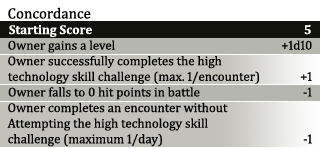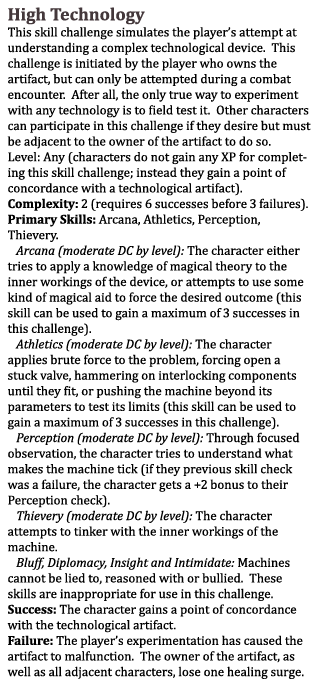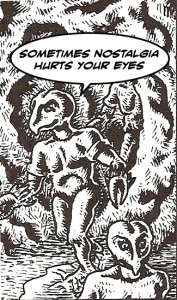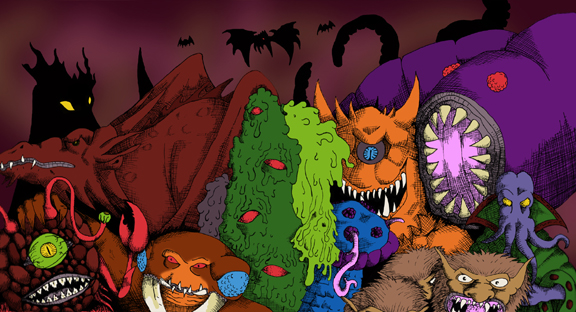Posts Tagged ‘Old-School’
Random Encounters: Powered Armor of the Barrier Peaks
December 24, 2010 Synchronicity (not just a great song by the Police, it’s also the most powerful weapon in Robotech) is to thank (/blame) for this post. Right around the time I read this D&D Alumni article about using the new Gamma World game to convert the classic module Expedition to the Barrier Peaks to 4e, I was exposed to the gonzo magnum opus, Booty and the Beast, over on Mr. Lizard’s gaming site. I was inspired.
Synchronicity (not just a great song by the Police, it’s also the most powerful weapon in Robotech) is to thank (/blame) for this post. Right around the time I read this D&D Alumni article about using the new Gamma World game to convert the classic module Expedition to the Barrier Peaks to 4e, I was exposed to the gonzo magnum opus, Booty and the Beast, over on Mr. Lizard’s gaming site. I was inspired.
It’s no coincidence (eh, synchronicity), that these two things should gel in my mind. Old School idol Erol Otus did the art for both products and both feature technological gadgets and weapons to incorporate into your fantasy rpg. The art and the crazy ideas in these two products are inspiring. It reminds me of a time when my mind was more open and new ideas were as easy as flipping open a comic, or turning on the TV and adding a few more ingredients to the mental stew. Sometimes it worked, sometimes it didn’t, but I was never afraid to try. Then I became a lot more serious about rpgs.
I have a confession. As cool as I thought it was (and I even owned a used 1e copy of Gamma World), I’ve never played Expedition. There’s a reason. When I was learning the ropes of DMing in public school, if I saw something I liked in one of the books, my players would find it (which led to the party’s ranger carrying a brace of magic short swords including a luck blade, nine-lives stealer, frostbrand, and more). While this was its own kind of fun, as I got older it started to lose its luster and I tried very hard at being a more serious DM. For me, when the players got their hands on machine guns and rocket launchers (putting the rpg in rpg) it was a sign that the game had gone to crazy town and the campaign was about to implode. So as much as, ‘it’s the adventure where you get to fight robots and pick up lasers’, appealed to me, it also had a giant blinking warning sign above it. Dungeons and Dragons was a tightly controlled universe that didn’t need game breaking technology floating around for the players to trip over (in high school I had a reputation as being pretty stingy with magic items). But there’s a part of me that’s very attracted to genre crossing (probably influenced by Marvel comics’ approach), which is probably why I found Rifts so refreshing in the 2e days (my love affair with Palladium is fodder for another post).
Skip ahead many years (too many) to the present. My head full of Otus Galactic Dragons and Bart Carroll issues the challenge to stat up the powered armor from Expedition. Now, I don’t own the new Gamma World, so I don’t know what an ‘omega tech’ card is, but I wanted to see if I was able to make a version of the armor that could be brought into a 4e game without destroying it. I decided to make it an artifact, since it appealed to the DM in me (artifacts are unique, easily controlled by the DM and are only in the game a limited time) and I thought the concordance mechanic was a good abstraction of the players trying to figure the thing out.
I’ve rambled on far enough without any goods to show for it, so without further ado I give you the powered armor of the Barrier Peaks.
The Powered Armor of the Barrier Peaks
Powered armor of the Barrier Peaks is appropriate for characters in the middle of the paragon tier and upward.
Goals of Powered Armor
• This artifact is not sentient and so has no goals of its own.
Roleplaying Powered Armor of the Barrier Peaks
Powered armor of the Barrier Peaks is different than other artifacts. It cannot communicate with its wearer and has no specific agenda it was created to pursue. It is the product of a foreign science even the most powerful archmagi find impossible to understand. Mastery of the item comes through experimentation and tinkering. Damaging the armor and allowing its power source to run unchecked will lead to the ruin, not just of the armor’s owner, but of everything around her.
Powered Armor of the Barrier Peaks Lore
History DC 20: Legend holds that the infamous steel clad dungeons of the Barrier Peaks were formed when the comet Warden crashed into the mountains decades ago. The winding passages of these mysterious halls are filled with exotic treasures and dangerous creatures seen no where else in the world. Perhaps the greatest treasure of all is the fabled suit of powered armor that is said to lie here, buried with the remains of the advanced race that built it.
History DC 25: Sages speculate that the alien magic used to create the powered armor of the Barrier Peaks is the same that drove the warlord Lum insane in his quest to build the gargantuan machine that bears his name.

Pleased (16-20)
“Your spells are quaint superstitions next to the technological might of super-science.”
The armor’s enhancement bonus increases to +5.
Power (Daily): Fusion Blast. Standard Action. Close burst 5 (enemies in burst); Constitution vs. Reflex; Hit: 4d6 + Constitution modifier fire and force damage and ongoing 5 fire damage.
Satisfied (12-15)
“The secrets of this strange magic begin to open up to me.”
Power (Daily): Force Field. Immediate Interrupt. You can use this power when you are hit by an attack that causes damage. You gain resist all 10 + Constitution modifier until the end of your next turn.
Normal (5-11)
“I sense great power here fore those with the wisdom to use it… and great danger for the ignorant.”
The wearer is just beginning to understand the armor’s potential. Careful testing of its capabilities in combat will unlock greater functions.
Unsatisfied (1-4)
“I know I can figure this thing out. I just need more time.”
The wearer has taken the armor for granted, using its capabilities without bothering to try and understand its systems. Overloads and malfunctions are becoming more commonplace.
The armor’s enhancement bonus drops to +3.
Special: The first time each day a critical hit is scored against you, you suffer ongoing 10 lightning damage (save ends). Aftereffect: you are weakened (save ends).
Angered (0 or lower)
“What does this button do?”
The armor is severely damaged and it is only a matter of time before a  complete critical systems failure.
complete critical systems failure.
The armor’s enhancement bonus drops to +2.
Special: The first time each day you score a critical hit make the following attack as a free action: critical malfunction; close burst 4 (allies in burst); Constitution vs. Reflex; Hit: 4d6 + Constitution modifier fire and force damage.
Moving On
“The flux capacitor is completely drained.”
All machines eventually break down, burn out, or run out of fuel. Even a fusion powered suit of armor. How and when the armor moves on depends on how well the artifact’s owner can control it.
When the powered armor of the Barrier Peaks reaches its limit, if it is at least satisfied, the owner is able to power it down during a non-critical time (during an extended rest, for instance) and avoid any catastrophes. In addition, time spent breathing the nanite filtered air has had beneficial side effects. The owner gains a permanent +2 bonus on Endurance checks, and can re-roll (keeping the higher roll) any failed Endurance check made to avoid suffocation or drowning damage.
An unsatisfied or angered suit of armor goes into critical meltdown at the most inopportune time. The armor explodes and makes the following attack (which includes the owner), close burst 5 (all creatures in burst); +20 vs. Reflex; Hit: 3d10+6 fire and force damage, and the target is knocked prone; Miss: half damage.
Notes:
I wanted to use a skill challenge to increase concordance because I felt it nicely replicated the complex flow charts that Expedition used to ‘simulate ignorance’ in the proper use of technological items. Players could experiment with these items during downtime, but the charts had some dangerous outcomes so there was real risk involved (losing charges, getting hurt or the item blowing up). Since my version of this item was an artifact and didn’t have charges, and given how healing and extended rests worked in 4e, that meant I would need to tweak things in order to preserve that element of danger. I felt a simple solution would be to make a skill challenge that could only be undertaken during a combat encounter. That way, if the players want to increase their understanding of the armor they have to be willing to sacrifice some of their combat actions (not to mention potentially losing a healing surge).
The picture is a twenty-one gun (or maser) salute to Erol Otus’ illustration of the power armor in Expedition. Somehow the 1970’s science fiction imagery of power armor just seems to fit D&D better than the anime aesthetic (although I do picture Gigantor as the mighty servant of Leuk-O).
Monsters of the Hyborian Age
December 12, 2010 The first ongoing project I want to work on is translating the monsters of the classic Conan stories to D&D 4th edition. It may be well trod territory (in previous editions at least – look at Arny on that 1e module cover!), but beyond the cool subject matter, I’d like to see if I can push the 4e mechanics by using elements in new ways, not just re-skinning goblins and orcs (over ambitious I’m sure).
The first ongoing project I want to work on is translating the monsters of the classic Conan stories to D&D 4th edition. It may be well trod territory (in previous editions at least – look at Arny on that 1e module cover!), but beyond the cool subject matter, I’d like to see if I can push the 4e mechanics by using elements in new ways, not just re-skinning goblins and orcs (over ambitious I’m sure).
In the famous ‘appendix N’ of the 1st edition Dungeon Masters Guide, Gary Gygax cites a list of books for inspirational reading that were literary influences on the game. Among these he lists Robert E. Howard’s Conan stories, and after the list reiterates that Howard (along with L Sprague de Camp, Fletcher Pratt, Fritz Leiber, Jack Vance, A.A. Merritt, and H.P. Lovecraft) had a particularly immediate influence on the game (Gygax also later claimed that Tolkien had little influence on the game, which is interesting but that’s a whole other can of worms). Now I’d seen the Conan movie (and still love it despite all the haters), and I’ve got a fair collection of Marvel’s Conan comic books, but I’m ashamed to admit I’ve never read any of the original Conan books. So in the spirit of getting in touch with my favorite hobby’s roots I picked up a copy of The Complete Chronicles of Conan, Centenary Edition and set about to educate myself.
First, the stories are great and the influence on D&D is clear on every page. I was surprised by Howard’s female characters, who seem more nuanced and powerful than most adventure fiction (yeah they’re sex objects as well but I had a lot less cringes reading this than re-watching Indiana Jones and the Temple of Doom – and this was written in the 30’s). I was disappointed by Howard’s portrayals of race, which made me feel uncomfortable and complicit (in a way, since I was reading the words), and sometimes threatened to break my immersion into the story. I don’t think this condemns the work outright any more than it would Huckleberry Finn or The Merchant of Venice, but it’s there. At least there were times when you coul d see that Howard was struggling with his views, testing out the boundaries of his own beliefs, something I never got the impression of when reading H.P. Lovecraft.
d see that Howard was struggling with his views, testing out the boundaries of his own beliefs, something I never got the impression of when reading H.P. Lovecraft.
The greatest part of the stories though, was the monsters! Now when it comes to the subject of bringing Conan to D&D, the prevailing wisdom has been that the Hyborian age was monster light. I have to say after reading the stories, if Conan’s exploits are any indication of the kinds of adventures that can be had, there was at least one (but usually more) monstrous opponent in each tale. Sure there were very few monster races, most of the creatures were unique, but you couldn’t flip over a rock without uncovering some alien god or bloodsucking demon. Besides, the idea is to create D&D monsters using the stories as source material, not create a Hyborian age 4e game.
I’m hoping to do a Hyborian monster every week or two, complete with illustration (because web content without a picture is one of my pet peeves). I might be biting off more than I can chew, but that’s what being a steel thewed barbarian is all about (that and passing out into a giant bowl of oatmeal).
These Are A Few Of My Favorite Things
December 9, 2010 The blog’s background image is an homage not just to my favorite D&D monsters, but also to my favorite old school artists. The images of early D&D products really captured my imagination as a child, so part of my love for them is pure nostalgia. When I picture a purple worm, in my head it has eyes (the memory is also wrapped up in playing the Dungeon! boardgame while listening to Prince’s Purple Rain as well, but that’s another story), even though the new-style, more alien looking purple worm looks a lot cooler. Now I’m not slagging the art used in rpgs now, without question it is of a much higher technical standard (and some old school art is abysmal, take a look at the crabman from the original Fiend Folio). Wayne Reynolds, for example, is an incredible artist (I especially dig his ‘wall of action’ stuff, like the 3.5 DM screen Paizo put out), but there’s no way in hell I can emulate the style of Wayne Reynolds, I’m just not that good (in fact I’m not really an artist at all). But that’s also part of the attraction of old school art. Looking at an early Erol Otus or Bill Willingham picture I get the impression that with enough practice and a little luck I could draw like them. In a hobby that emphasizes do-it-yourself and fan-created material this kind of realistic goalpost gives the pieces special meaning. Even though I’ve never met them, it created a special kind of bond between me and the D&D artists of my childhood. In the end it’s probably just a fancy way of justifying my nostalgic over attachment to these images and my poor art skills, but hey isn’t that what blogging’s all about?
The blog’s background image is an homage not just to my favorite D&D monsters, but also to my favorite old school artists. The images of early D&D products really captured my imagination as a child, so part of my love for them is pure nostalgia. When I picture a purple worm, in my head it has eyes (the memory is also wrapped up in playing the Dungeon! boardgame while listening to Prince’s Purple Rain as well, but that’s another story), even though the new-style, more alien looking purple worm looks a lot cooler. Now I’m not slagging the art used in rpgs now, without question it is of a much higher technical standard (and some old school art is abysmal, take a look at the crabman from the original Fiend Folio). Wayne Reynolds, for example, is an incredible artist (I especially dig his ‘wall of action’ stuff, like the 3.5 DM screen Paizo put out), but there’s no way in hell I can emulate the style of Wayne Reynolds, I’m just not that good (in fact I’m not really an artist at all). But that’s also part of the attraction of old school art. Looking at an early Erol Otus or Bill Willingham picture I get the impression that with enough practice and a little luck I could draw like them. In a hobby that emphasizes do-it-yourself and fan-created material this kind of realistic goalpost gives the pieces special meaning. Even though I’ve never met them, it created a special kind of bond between me and the D&D artists of my childhood. In the end it’s probably just a fancy way of justifying my nostalgic over attachment to these images and my poor art skills, but hey isn’t that what blogging’s all about?
My favorite things from left to right:
Eye of the Deep: Beholders are one of D&D’s most iconic monsters, and I’ve always felt that its undersea cousin needed a bit more love. Before I knew any better I thought the eye of the deep was more powerful than the beholder – it had pincers and eye rays! (Inspired by Jean Wells’ illo. from the Monster Manual).
Red Dragon: They’re in the game’s name, you can’t do a picture featuring D&D monsters and not include them… plus, I really like dragons. (Inspired by any Jeff Easley dragon – including Jeff Easley in here kind of busts my whole ‘I could draw like them’ idea. There’s no way I could really emulate his style but I absolutely adore his paintings so I at least tried to capture the form of his dragons).
Water Dragon (silhouette): I’m actually not sure what kind of dragon this was. It could just as easily been a green dragon, but it’s hard to tell. (Inspired by Erol Otus’ cover for the Basic Dungeons and Dragons rulebook).
Umber Hulk: Once upon a time umber hulks were hulking. And for the record the color scheme is not inspired by (awesome) Olympic mascot Quatchi, I was going more for the rubber umber hulk made by LJN Toys in the 80’s. (Inspired by Jeff Dee’s illo. from the module The Ghost Tower of Inverness).
Jubilex: The dungeons of D&D are teeming with a cornucopia of oozes and slimes. If I’m going to draw a picture of one why not go for the granddaddy of them all. (Inspired by David A. Trampier’s illo. from the Monster Manual).
Stirge (silhouette): As a kid I spent a lot of summers in mosquito infested northern Ontario, so these bloodsuckers hold a certain resonance with me. (Inspired by David Sutherland III’s illo. from the Monster Manual).
Violet Fungi: With so many fungal based monsters in the game, I blame D&D for giving me the paranoid belief that eating mushrooms will infect me with their spores. (Inspired by Erol Otus’ illo. from the module Expedition to the Barrier Peaks).
Astral Dreadnought: This behemoth (not really to scale), never got a set of official stats until 2nd Edition even though it graced the cover of the Manual of the Planes. (Inspired by another great Jeff Easley painting).
Bugbears: While I was DMing The Temple of Elemental Evil in high school, the rules for reinforcing the forces of evil combined with the long healing times of the PC’s to create a population explosion of these critters. Ever since bugbears and I have had a bad reputation. (Inspired by Erol Otus’ illo. from Hackmaster).
Purple Worm: Better than a Shai-Hulud. (Inspired by David Sutherland III’s illo. from the Monster Manual).
Mind Flayer: Saved the best for last. Brain eating, mind controlling, tentacle creatures from the bowels of the earth. What’s not to love? (Inspired by the Bill Willingham illo. from the module Descent into the Depths of the Earth).
